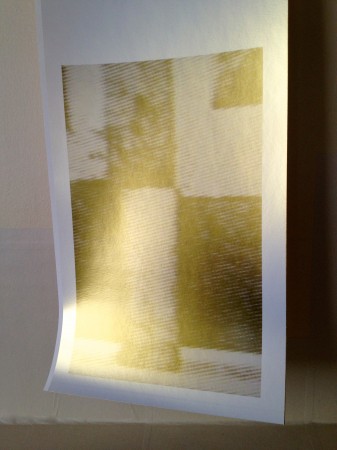10 December 2015 to 6 February 2016

With varying speeds: flash, snap, enlarge, expose…
Like a relay race, the subject matter of Little Glow has passed through, and along, multiple vectors. The source: burlap walls, vases, and drapes – anachronistic display apparatuses of 291, the iconic New York gallery run by Alfred Stieglitz from 1905 – 1917. The aftereffect: a two-part installation that offers a simulation of the historic gallery via a system of perpetual reproduction.
hang, publish, zoom, capture…
Crucial to Lycan’s project is a methodology of exchange and transformation through the mediating effects of technology and environment. Embedded within her work are layers of negotiation; one translation after another contains the potential for a virtually infinite number of abstractions. As Vilém Flusser remarks on technical images, they are a consolidation of “invisible possibilities into visible improbabilities”. This approach engages photography only to push it beyond medium specificity into a fluid quality of relations that blur the distinction between production and mass-consumption, content and style, time and place. Here, the real becomes replica, representation becomes abstract, and image becomes object.
upload, colour, shift, crop…
While at first it may seem that Lycan’s process causes total decontextualization, total abstraction, the images and their method of display remain haunted by their antecedent. On the main floor of the gallery loosely tacked coloured photocopies cascade down and across white walls. The sources for these photocopies are images of the painted burlap that covered 291’s walls. Like their verb-filled past, the five-hundred and forty images displayed continue to respond to their fluctuating context. Whether from passerby or breath of wind, the work sways as a sky draped with cirrus clouds. A recall of Stieglitz’ cloud photographs from his Equivalents series? Recognized as the first abstract photographic works of art, the majority of Equivalents featured only cloud and sky devoid of horizon. They placed emphasis on atmosphere over framework in an attempt to free subject matter from literal interpretation.
scan, print, copy, copy again…
Upstairs, from floor-to-ceiling, newsprint papers the walls. Here, the void material becomes proxy for the burlap walls pictured downstairs. Like the textured walls of 291, Lycan’s application softens the ground for the images hung on top. Their blankness suggests that they are awaiting information. But, being light sensitive, the paper itself contains the ability to become imprinted with slow time passing. On top float a scattering of images that, once removed at the exhibition’s close, will immaterially expose their prior material presence. Transformed through various processes of facsimile, these are images in flux. The result barely conveys their subject: flowers in vases.
laminate, pin, frame, click…

